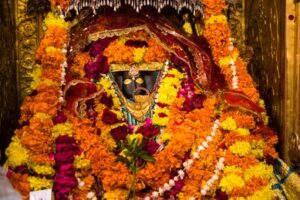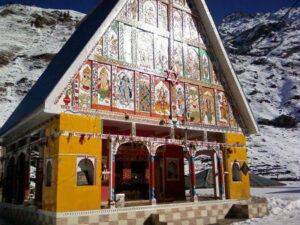
Religion holds a paramount place in the lives of individuals, exerting profound influence across a spectrum of human experiences including spirituality, material prosperity, and emotional contentment thereby becoming interwoven with almost every aspect of our day-to-day actions. Within this tapestry of religious beliefs and practices, one particularly intriguing intersection arises when religion converges with the realm of politics. This intersection may manifest itself in several different ways and hence can impact its audience differently. This essay aims to delve into the interaction between religion and politics and its impact on the masses who often act as observers rather than direct participants in these interactions. Religious information is often conveyed through dedicated narratives (known as “Kathas”) or musical performances (such as “bhajans” and “artis”). These forms of expression are accessible even to those who may be illiterate, offering engaging avenues to connect with the historical and spiritual aspects of their religion.
While the exploration of a region’s political history typically relies on written documents, incorporating local narratives and stories can provide a more nuanced understanding of the intricate relationship between politics, religion, and the common people. In this essay, we will employ a combination of oral narratives, religious musical performances, secondary sources, and historical events to examine various facets of religio-political interactions and their diverse impacts on different audiences.
In order to illustrate the interrelation between politics and religion and the impact on varied audiences, we shall take up three case studies: that of Bave Vali Mata, Machail Mata, and Baba Jitto.
Bave Vali Mata is a revered deity whose temple is constructed at the bank of river Tawi, a tributary of Jhelum in the main Jammu city. It is believed that Raja Jambu Lochan—from whose name the word Jammu is derived—had constructed her temple and brought her idol from Calcutta. An important dimension of politico-social significance of Bave Vali Mata is her view as the protector of the people of Jammu. It is stated that during the battles of 1965 and 1971 with Pakistan, she shielded the people of Jammu from bombs showered from the opposite side. It is further stated in her folk story that she came in the dreams of many showing her burnt hands due to the bombs showered by the enemy. It is stated that when the opponent army wished to target the area, they could see only water throughout.
This incident illustrates how religion and political events can interact to strengthen both. Such a process is actually hard to scientifically prove, but it is aimed to illustrate the ever evolving power of Mata to protect the people of the region. It is also possible that due to events like warfare, faith of the masses in religion is questioned if not shaken. Such addons to the story can actually make a rehabilitation of this faith. Finally, this aspect can also be seen as a means to strengthen the morality of the war. By illustrating that the deity protected people of the region, it could be reinforced that the cause for war was quite fair as gods are always on the side of those who are right.

Next, we take up the scenario of a mingling of religion and politics as observed in the case of Machail Mata. Machail Mata is enshrined in the Machail area of Kishtwar district of Jammu province of Jammu and Kashmir. She is greatly known for several miraculous events like causing a movement in her earrings without the application of any kind of force. An event extolling her praise has been shortlisted to investigate the relationship between religion and political events. It is believed that General Joravar had sought her blessings prior to going for his mission to Gilgit. His victory in this mission is ascribed to the blessings of Machail Mata. Such a story makes the belief of people in the deity quite firm. It also helps to spread her tale far and wide, attracting a huge audience of the deity. It can also sanctify the mission.

The story of Baba Jitto is a bit different. It throws light on how local heroes can attain the status of a godly figure. There are different versions of the Baba Jitto narrative ever expanding and shaped in different divine ways. It is believed that Baba Jitto or Jit Mal (original name) was born to a Brahman named Roop Chand and Jojla Devi in Aghar region of Katra in Reasi district of Jammu. He married Maya Devi who died while giving birth to their daughter. He had to leave his village and move to the region today known as Chhiddi. Reason for leaving the village has been cited differently in different versions. Some stories attribute this to the torture of his Aunt Jojja and other consider the illness of his daughter to be the reason for moving to a different village. At Chhidi, he came to his friend and asked for a portion to be able to sustain his livelihood. His friend took this case to Bir Singh Mehta who was a landlord associated with the royal family of the regional kingdom. Bir Singh gave him a fallow land and asked him to give one-fourth of the produce to the royal family as tax. Jit Mal agreed to it and worked hard to produce sufficient crops. His hard work paid and the produce was plentiful. Bir Singh, seeing the produce, turned greedy. He now demanded half of the produce as tax. After trying hard to convince the landlord for the previously fixed amount of the produce and failing to do so, Jitto thought it better to die rather than bowing down before the unjust. He stood on his crop and killed himself with a sword. It is believed that Bir Singh’s entire family died of disease as an impact of the curse of Jitto.
Link between this story and politics may not be visible but it’s quite evident. Baba Jitto is celebrated as somebody who did not surrender to the unfair demands of the landlord. This story may be viewed as a representation of a protest against the oppression of landlords who exploit the peasants solely because they belong to the royal class. In the later part of story, it is mentioned that the king for whom Bir Singh worked built the Baba Jitto Temple at Chhidi post Baba Jitto’s sacrifice and destruction of Bir Singh’s family.This act can be seen as a way to respect the religious beliefs of those who considered Baba Jitto a divine figure. This story demonstrates a complex relationship between religion and politics. It shows how someone who opposes the excessive power of political leaders can become a religious hero for the people and then, political leaders honour that hero to gain legitimacy in both religious and social contexts. In this case, religion and politics both expand, as a local heroe’s divinely attributes are legitimised through the intervention of a political leader and political leaders find a way to gain support from the masses and people of high religious stature.
This essay has undertaken an examination of three case studies with the objective of elucidating the intricate interplay between religion and political events. These case studies collectively manifest a unique yet interconnected pattern of politico-religious dynamics. Notably, the narratives of Bave Wali Mata and Machail Mata manifest instances where political events are strategically harnessed to reinforce the divine authority of a deity. The narrative of Baba Jitto serves as an example of how political figures can consolidate their authority by venerating a local hero and how local heroes can acquire a divine status. In parallel, the narratives of Machail Mata and Bave Vali Mata illuminate the phenomenon of Puranic acculturation, though it is noteworthy that Baba Jitto, in a broader context, has not been systematically equated with a Puranic deity. Nonetheless, scattered references do exist that posit Baba Jitto as a manifestation of Brahma.
In terms of their impact on the audience, all three narratives hold relevance in the broader societal context. However, the narratives of Baba Jitto and Machail Mata may yield specific lessons of pertinence to political entities. Similarly, the tale of Bave Vali Mata may resonate more profoundly with individuals directly involved in conflicts, such as soldiers or military commanders. In summation, the multifaceted nexus between religion and politics continues to evolve, providing a diverse and expansive horizon from which individuals can glean distinct lessons.

